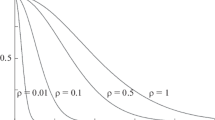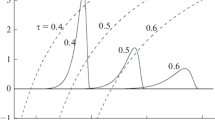Abstract
The acceleration of energetic particles and their propagation in magnetic fields of the solar wind and the Galaxy is a topical astrophysical problem. Cosmic rays (CR) affect communications and the operation of on-board spacecraft electronics and disturb the magnetosphere and the ionosphere of the Earth. The scattering of particles by magnetic-field irregularities is the primary mechanism governing the CR propagation in the interplanetary medium. If the scattering of energetic particles in the interplanetary medium is relatively inefficient (i.e., the mean free path is comparable to the heliocentric distance), a kinetic equation should be used to characterize the CR propagation. The Fokker–Planck kinetic equation is used to analyze the propagation of charged energetic particles in a magnetic field represented as a superposition of a mean uniform field and magnetic inhomogeneities of various scales. This kinetic equation corresponds to multiple small-angle scattering, and its collision integral characterizes particle diffusion in the momentum space. A system of differential equations for the spherical harmonics of the CR distribution function is obtained based on the kinetic equation. The CR transport equations are derived and solved. The evolution of the CR distribution function under anisotropic scattering of particles by magnetic-field fluctuations is examined. It is demonstrated that the angular distribution function of particles depends to a considerable extent on the degree of their scattering anisotropy. The temporal dependence of the CR distribution function is analyzed, and the parameter characterizing the scattering anisotropy is estimated.









Similar content being viewed by others
REFERENCES
B. A. Gal’perin, I. N. Toptygin, and A. A. Fradkin, “Scattering of particles by magnetic inhomogeneities in a strong magnetic field,” J. Exp. Theor. Phys. 33, 526–531 (1971).
A. P. Prudnikov, Yu. A. Brychkov, and O. I. Marichev, Integrals and Series (Nauka, Moscow, 1981; Gordon and Breach, New York, 1986).
I. N. Toptygin, “On the time dependence of the intensity of cosmic rays at the anisotropic stage of solar flares,” Geomagn. Aeron. 12, 989 (1972).
I. N. Toptygin, Cosmic Rays in Interplanetary Magnetic Fields (Nauka, Moscow, 1983; Reidel, Dordrecht, 1985).
Yu. I. Fedorov, “Intensity of cosmic rays at the initial stage of a solar flare,” Kinematics Phys. Celestial Bodies 34, 1–12 (2018).
V. I. Shishov, “On propagation of high-energy solar protons in the interplanetary magnetic field,” Geomagn. Aeron. 6, 223 (1966).
W. I. Axford, “Anisotropic diffusion of solar cosmic rays,” Planet. Space Sci. 13, 1301 (1965).
J. Beeck and G. Wibberenz, “Pitch angle distributions of solar energetic particles and the local scattering properties of the interplanetary medium,” Astrophys. J. 311, 437 (1986).
J. W. Bieber, J. A. Earl, G. Green, et al., “Interplanetary pitch-angle scattering and coronal transport of solar energetic particles: New information from Helios,” J. Geophys. Res.: Space Phys. 85, 213 (1980).
J. W. Bieber, P. A. Evenson, and M. A. Pomerantz, “Focusing anisotropy of solar cosmic rays,” J. Geophys. Res.: Space Phys. 91, 8713 (1986).
L. I. Dorman and M. E. Katz, “Cosmic ray kinetics in space,” Space Sci. Rev. 70, 529–575 (1977).
J. A. Earl, “Diffusion of charged particles in a random magnetic field,” Astrophys. J. 180, 227 (1973).
J. A. Earl, “New description of charged particle propagation in random magnetic field,” Astrophys. J. 425, 331 (1994).
F. Effenberger and Y. Litvinenko, “The diffusion approximation versus the telegraph equation for modeling solar energetic particle transport with adiabatic focusing. 1. Isotropic pitch angle scattering,” Astrophys. J. 783, 15 (2014).
Yu. I. Fedorov, B. A. Shakhov, and M. Stehlik, “Non-diffusive transport of cosmic rays in homogeneous regular magnetic fields,” Astron. Astrophys. 302, 623–634 (1995).
Yu. I. Fedorov, M. Stehlik, K. Kudela, and J. Kassavicova, “Non-diffusive particle pulse transport: Application to an anisotropic solar GLE,” Sol. Phys. 208, 325–334 (2002).
Yu. I. Fedorov and B. A. Shakhov, “Description of non-diffusive cosmic ray propagation in a homogeneous regular magnetic field,” Astron. Astrophys. 402, 805 (2003).
L. A. Fisk and W. I. Axford, “Anisotropies of solar cosmic rays,” Sol. Phys. 7, 486 (1969).
T. J. Gombosi, J. R. Jokipii, J. Kota, et al., “The telegraph equation in charged particle transport,” Astrophys. J. 403, 377 (1993).
K. Hasselmann and G. Wibberenz, “Scattering charged particles by random electromagnetic fields,” Z. Geophys. 34, 353 (1968).
K. Hasselmann and G. Wibberenz, “A note of the parallel diffusion coefficient,” Astrophys. J. 162, 1049 (1970).
J. R. Jokipii, “Cosmic ray propagation. 1. Charged particle in a random magnetic field,” Astrophys. J. 146, 480 (1966).
E. Kh. Kagashvili, G. P. Zank, J. Y. Lu, and W. Droge, “Transport of energetic charged particles. 2. Small-angle scattering,” J. Plasma Phys. 70, 505–532 (2004).
J. Kota, “Coherent pulses in the diffusive transport of charged particles,” Astrophys. J. 427, 1035–1080 (1994).
G. Li, R. Moore, R. A. Mewaldt, et al., “A twin-CME scenario for ground level enhancement events,” Space Sci. Rev. 171, 141 (2012).
Yu. E. Litvinenko and P. L. Noble, “Comparison of the telegraph and hyperdiffusion approximations in cosmic ray transport,” Phys. Plasmas 23, 062901 (2016).
M. A. Malkov and R. Z. Sagdeev, “Cosmic ray transport with magnetic focusing and the "telegraph” model,” Astrophys. J. 808, 157 (2015).
L. I. Miroshnichenko and J. A. Perez-Peraza, “Astrophysical aspects in the studies of solar cosmic rays,” Int. J. Mod. Phys. A. 23, 1 (2008).
N. A. Schwadron and T. I. Gombosi, “A unifying comparison of nearly scatter free transport models,” J. Geophys. Res.: Space Phys. 99, 19301 (1994).
B. A. Shakhov and M. Stehlik, “The Fokker–Planck equation in the second order pitch angle approximation and its exact solution,” J. Quant. Spectrosc. Radiat. Transfer 78, 31–39 (2003).
M. A. Shea and D. F. Smart, “Space weather and the ground-level solar proton events of the 23rd solar cycle,” Space Sci. Rev. 71, 161 (2012).
G. M. Webb, M. Pantazopolou, and G. P. Zank, “Multiple scattering and the BGK Boltzmann equation,” J. Phys. A Math. Gen. 33, 3137–3160 (2000).
G. Wibberenz and G. Green, “New methods and results in the field of interplanetary propagation,” in Proc. 11th Eur. Cosmic Ray Symp., Balatonfüred, Hungary, Aug. 21–27, 1988, Invited Talks (Központi Fizikai Kutató Intézet, Budapest, 1989), p. 51.
Author information
Authors and Affiliations
Corresponding author
Additional information
Translated by D. Safin
About this article
Cite this article
Fedorov, Y.I. Cosmic-Ray Distribution Function under Anisotropic Scattering of Particles by Magnetic-Field Fluctuations. Kinemat. Phys. Celest. Bodies 35, 1–16 (2019). https://doi.org/10.3103/S0884591319010021
Received:
Revised:
Accepted:
Published:
Issue Date:
DOI: https://doi.org/10.3103/S0884591319010021




